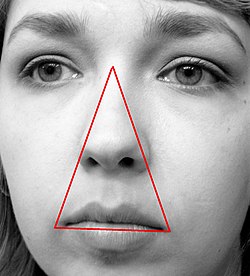Danger triangle of the face
| Danger triangle of the face (Nasolabial triangle) | |
|---|---|
 | |
| Anatomical terminology |
The danger triangle of the face consists of the area from the corners of the mouth to the bridge of the nose, including the nose and maxilla.[1][2] : 345–346 Due to the special nature of the blood supply to the human nose and surrounding area, it is possible for retrograde infection from the nasal area to spread to the brain, causing cavernous sinus thrombosis, meningitis, or brain abscess.
This is possible because of veinous communication (via the
It was discovered that venous valves are present in the ophthalmic and facial veins. Thus, it is not the absence of venous valves but rather the existence of communications between the facial vein and cavernous sinus and the direction of blood flow that is important in the spread of infection from the face. Most people, but not all, have valves in these particular veins of the face.[4]
The relationship between this area and a risk of cavernous sinus
Infection of cavernous sinus
If the cavernous sinus is infected, it can cause the blood within the sinus to clot, resulting in a cavernous sinus thrombosis. This affects the structures that are going through it or surround it. Inside the cavernous sinus, constriction of the following cranial nerves (CN) can be found: CN III (oculomotor nerve), CN IV (trochlear nerve), CN VI (abducens nerve), CN V (trigeminal nerve), specifically V1 (ophthalmic nerve) and V2 (maxillary nerve) branches. Failure of each of the nerves listed above will manifest in loss of function of the specific muscle, gland, or parasympathetic innervations (from CN III). In addition, it is possible that inflammation of the cavernous sinus will result in compression of the optic chiasm (resulting in vision problems) and/or the pituitary gland.[citation needed]
Failure of CN III will result in loss of function of the following muscles:
References
External links
- "Cavernous sinus thrombosis: Introduction". National Health Service. 10 February 2006.
- "Nasal Abscess in Danger Area of Face". Retrieved 8 April 2011.
